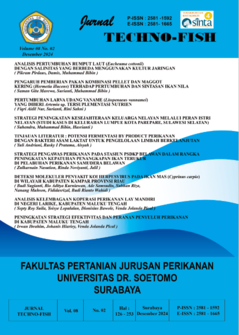Main Article Content
Abstract
Eucheuma cottonii seaweed is a marine cultivation commodity that is reliable, easy to cultivate and has good market prospects and can increase the income of farmers in coastal communities. One of the problems in seaweed cultivation is the salinity of different seaweeds, whether there is significant change or growth. The aim of this research is to determine the effect of different salinities on the growth of the seaweed Eucheuma cottonii using the tissue culture method. This research will be carried out in January-February 2024, seaweed (Eucheuma cottoni) will be studied with different salinities using tissue culture analysis at the Laboratory of the Faculty of Science and Technology, Muhammadiyah University of Sidenreng Rappang. This research is an experimental study with a Completely Randomized Design (CRD) consisting of 3 treatments and 3 replications. This treatment was carried out with different salinities, namely 25 ppt, 35 ppt and 45 ppt using tissue culture. The treatment being tested was a type of seaweed seed (Eucheuma cottoni). The equipment used is a digital weighing scale, meter, refractometer, thermometer, jar, cutter, book, pen, pH meter, aerator, neat rope and measuring cup. Specific Daily Growth Rate Determination of the specific daily growth rate of seaweed measured at each week (sampling) of observations for six weeks (± 28 days). During the research, water quality parameters became an important factor to use as a benchmark to determine the quality standards for good water quality in the seaweed growth process, including temperature, salinity and pH that were measured. And the data analysis in this research is quantitative and is calculated from each treatment that will be tested using SPSS, in accordance with the experimental design used, namely a completely randomized design (RAL). The output of this research plan will produce scientific articles which will be published in the Accredited National Journal Sinta 4.
Article Details

This work is licensed under a Creative Commons Attribution-NonCommercial-NoDerivatives 4.0 International License.

This work is licensed under a Creative Commons Attribution-NonCommercial-ShareAlike 4.0 International License
References
- [1] D. D. AS, “Analisis daya dukung lahan budidaya rumput laut di teluk laikang kabupaten takalar,” pp. 1–25, 2022.
- [2] A. Mardiana, A. S. Sahnitasari, I. Lahardi, and F. Afdal, “Kolaborasi Pemerintah Dan Pelaku Usaha Sulawesi Tengah Untuk Mengembangkan Komoditas Rumput Laut,” Wawasan J. Ilmu Manajemen, Ekon. dan Kewirausahaan, vol. 2, no. 2, pp. 1–20, 2024.
- [3] A. Marsaude, A. Sukainah, and Patang, “Kajian Kualitas Perairan Pada Lahan Budidaya Rumput Laut (Eucheuma cottoni) Di Kecamatan Mandalle Kabupaten Pangkep,” J. Rev. Pendidik. dan Pengajaran, vol. 6, no. 4, pp. 1325–1332, 2023.
- [4] A. Anton, “Pertumbuhan dan Kandungan Agar Rumput Laut (Gracilaria spp) Pada Beberapa Tingkat Salinitas,” J. Airaha, vol. 6, no. 2, pp. 054–064, 2017, doi: 10.15578/ja.v6i2.70.
- [5] A. Pratama, I. G. Ngurah, and P. Dirgayusa, “Studi Pertumbuhan Rumput Laut Jenis Kotoni ( Eucheuma cottonii ) dengan Menggunakan Metode Kurung Dasar dan Lepas Dasar di Perairan Geger , Bali,” vol. 3, pp. 47–58, 2017.
- [6] K. Yudiastuti, I. G. B. S. Dharma, and N. L. P. R. Puspitha, “Laju Pertumbuhan Rumput Laut Gracilaria sp Melalui Budidaya IMTA (Integrated Multi Trophic Aquaculture) di Pantai Geger, Nusa Dua, Kabupaten Badung, Bali,” J. Mar. Aquat. Sci., vol. 4, no. 2, p. 191, 2017, doi: 10.24843/jmas.2018.v4.i02.191-203.
- [7] Khasanah, “Analisis Kesesuaian Perairan Untuk Lokasi Budidaya Rumput Laut Eucheuma cottonii Di Perairan Kecamatan Sajoanging,” p. 18, 2013.
- [8] P. Perairan, K. Sinjai, and S. Selatan, Budidaya rumput laut.
- [9] N. S. Andre, “Perbandingan Pertumbuhan Dan Kandungan Pigmen Rumput Laut Eucheuma cottonii Lokal Dan Hasil Kultur Jaringan,” JFMR-Journal Fish. Mar. Res., vol. 7, no. 1, 2023, doi: 10.21776/ub.jfmr.2023.007.01.6.
